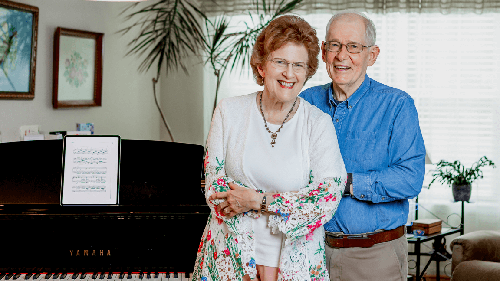
Whether you’re exploring retirement options for yourself or a loved one, it’s crucial to understand the average retirement home cost. While the average cost of senior living near you will vary based on your location, taking the time to grasp the approximate range of these expenses allows you to make a well-informed decision that fits both your budget and lifestyle.
What is an Entrance Fee at a Retirement Community?
An entrance fee at a retirement community is a one-time upfront payment made by residents when they join the community. Many facilities require entrance fees, especially Continuing Care Retirement Communities (CCRCs), sometimes called Life Plan Communities, where residents can transition to higher levels of care when needed and not have to move out of the community. Entrance fees at CCRCs are used in part to cover the cost of expanding healthcare needs.
According to the U.S. Government Accountability Office, that fee varies wildly, and can be anywhere from $1,800 to $600,000, depending on the type of CCRC contract. The higher figure represents an entrance fee for a Type A CCRC contract, while the lower figure more accurately depicts the entrance fee for a Type D CCRC contract. The main difference is in how costs are handled when health services are required. With Type A, changing from independent living to assisted living or skilled nursing care will typically result in no increase to your monthly fee. With Type D, you will likely need to pay the current market rate for these services, which can cause your monthly budget to increase by many thousands of dollars.
Some CCRCs offer refundable entrance fees, which are usually significantly higher than non-refundable entrance fees.
Average Monthly Cost for Senior Living Communities
The average monthly cost for senior living communities can vary widely based on several factors including the type of community, its location, the level of care provided, and the amenities offered. According to the U.S Government Accountability Office, the average monthly cost for assisted living communities ranges from $1,500 to $6,500, while the average monthly cost for skilled nursing facilities ranges from $1,500 to $10,700. Independent living can fall below that, since health services likely aren’t required, but keep in mind they can increase depending on the level of amenities involved.
Independent living monthly fees cover your living space along with add-ons designed to make your life easier, more fun, or safer. For example:
- Upscale dining
- State-of-the-art fitness centers
- Weekly scheduled events, outings, classes, and more
- Resort-style amenities such as swimming pools and putting greens
- Cleaning, laundry and other services
- On-site medical resources
Aging in Place: The Cost of Not Moving
If the cost of senior living near you seems expensive, let’s look at the cost of taking the other path: aging in place at your current home (or your loved one’s home, if you’re researching for a relative). It’s no surprise that most older Americans prefer to stay right where they are – in the home they’ve lived in for years and where they’ve made many happy memories.
But the hard truth is that this option often turns out to offer many more challenges over time. There are plenty of financial stumbling blocks including a myriad of costly health concerns that can crop up when seniors live alone in a house that’s too much for them to manage.
Cost of Home Maintenance and Accessibility Updates
“Without changes to how communities are constructed and services are delivered, older adults may find it increasingly difficult to age in place.” - AARP Research Report, Aging in Place: a State Survey of Livability Policies & Practices
As we age, our homes become increasingly difficult to maintain. And don’t forget property taxes, which don’t typically get cheaper. In fact according to Tax Foundation, they’ve been known to rise as much as 19 percent in four years!
Eventually, it becomes difficult to manage the daily tasks of living unless significant home modifications are made. One CNBC expert estimates the total cost of these changes to be $20,000 to $30,000, while others at MarketWatch put the figure much higher, up to $100,000. These include:
- Grab bars
- Ramp
- Bathroom remodel
- Better lighting
- Wider doorways
- Kitchen modifications
- Safer flooring options
- Easy-grip doorknobs
- Stair lifts
This also doesn’t factor in grocery shopping, home maintenance, lawn care, shoveling, and other chores and needs.
Cost of In-Home Care
As people grow older, they tend to begin to need in-home care. It might start out with just a few hours of help with chores each week. Over time, many seniors also need transportation services, meals, and even help with dressing and other daily chores. Here’s what that GenWorth.com estimates it can cost:
- Homemaker services: $48,048 per year
- Home Health Aide: $50,336 per year
- Adult Day Health Care: $18,720 per year
Compared with the average cost of senior independent living – $48,000 per year for Assisted Living – aging in place could turn out to be financially difficult. Moving to a retirement community could in fact turn out to be unexpectedly good for the finances.
The other factor to consider is that moving to a retirement community is often an opportunity to downsize, which means less space to need to maintain and keep clean, and less risk for falls and other health concerns. Many people as they age actually end up preferring a one- or two-bedroom apartment with no steps and everything they need close together.
Cost of Isolation
Although it’s typical for people to state a preference for staying in their current home and community as they age, it’s easy to forget the challenges that brings. Over time, as seniors lose touch with their network of friends and become less mobile, social isolation can set in. According to a growing body of studies, inadequate amounts of social interaction can be deadly for seniors.
In fact, loneliness in seniors has been found to be twice as dangerous as being obese and just as detrimental as being a smoker. By staying social, the National Center for Biotechnology Information asserts that seniors can also boost immunity and reduce inflammation that can lead to chronic illness.
That brings us to one of the surprising financial benefits of moving to a retirement community: saving on medical costs by staying healthy.
You or your relative will find a multitude of ways to stay connected. Whether it’s through lunch dates with your neighbors or regular outings to cultural events or senior fitness classes, these communities are very good at making sure nobody feels isolated. Classes and activities also keep everyone mentally stimulated and engaged.
The Hidden Benefits of Community Living
So, what’s better: aging in place or moving to a retirement community? It’s definitely your call – nobody can make that choice for you. Even after taking all these different factors into mind, it might be hard to see which way the scales tip.
But you now have the facts. Hopefully that’s given you a firm understanding of the cost of retirement communities. Now, we invite you to take the next step and shop around. If you think community living might be for you or an older relative, feel free to select an Acts community and get pricing information. It’s free and there are absolutely no strings attached!






